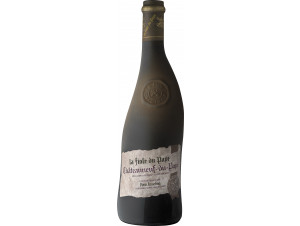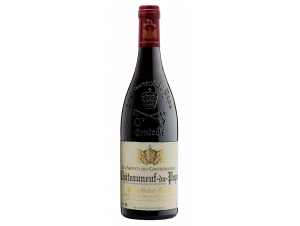You have no items in your shopping cart.
Wine Châteauneuf-du-Pape
This is one of the greatest French crus: the Appellation d'Origine Contrôlée (AOC) Châteauneuf-du-Pape. Located in the Vaucluse department, this remarkable vineyard has a unique history in France. Indeed, this prestigious wine appellation was the first to benefit from the country's Appellation d'Origine Contrôlée on 15 May 1936. Read more on Châteauneuf-du-Pape
-
Top Selling-34%
-
Top Selling-16%
-
Top Selling
- -20%
- -21%
- -15%
- -10%
- -34%
Appellation Châteauneuf-du-Pape
The name of the AOC Châteauneuf-du-Pape takes its name from the Popes
Located in the southern Côtes du Rhône region, discover the exceptional history of the first Appellation d'Origine Contrôlée in France.
The AOC Châteauneuf-du-Pape, takes its name from the time when the Popes came to settle in Avignon, in the 14th century. It is thus between the years 1309 and 1378, that this famous wine was born and was quickly recognized. From the beginning of his reign, Pope John XXII had a fortress built on the heights of the commune that could accommodate all the Popes of Avignon. The Châteauneuf vineyard is forever dominated by the old Tower where they lived.
The traditional "papal" method of cultivation in the City of the Popes of Avignon, was long perpetuated by the winegrowers of the region. At the time, the success of this wine was such that it was for a long time subject to the jealousy of its Burgundian neighbours. These tried, by all means, to cause the decline of this amazing vineyard.
12 years before the creation of the Institut National des Appellations d'Origine, of which Châteauneuf-du-Pape is the precursor, the winegrowers of the commune were already complying with the regulations that were finally applied. Châteauneuf-du-Pape was thus at the origin of the first true AOC in France, in 1936.
It produces mainlyred wines, of rare quality; but also excellent, if rarer, white wines. These represent only 1% of the total production of AOC Châteauneuf-du-Pape. They are generally tasted in the early years. This AOC is produced on a vineyard comprising 5 communes (Bédarrides, Courthézon, Orange, Sorgues and Châteauneuf-du-Pape.) The landscape opens up to a magnificent view, revealing the vast plateaus covered with rolled pebbles and quartz, with a view plunging down to the left bank of the Rhône.
The Châteauneuf-du-Pape appellation is characterised by rugged soils
In Châteauneuf, there are a multitude of Mediterranean-type microclimates. Some plots are protected from the mistral, but the tendency to drought is strong. It is a very sunny southeastern commune, with at least 2,800 hours of sunshine per year, and an average temperature of around 14°C over the year. Like many vineyards in the region, the soils of this terroir are particularly uneven, stony and chalky. There are huge terraces covered with quartz, pebbles and red clay.
13 grape varieties are traditionally used in the blend of AOC Châteauneuf-du-Pape including Cinsault, Grenache, Mourvèdre, Roussane and Syrah. On average, 95,000 hectolitres of red wines are produced (93%), and only 6,500 hectolitres of white wines (7%); for a maximum authorised yield of 35 hectolitres per hectare, making it one of the lowest authorised in France. The vineyard has a production area of 3,145 hectares, with 290 vineyards.
What are the specificities of the Châteauneuf du Pape vineyard?
The winegrowers, anxious to offer high quality wines, but also to work towards respecting the environment, have long since chosen a unique method of cultivation. To allow the vines to flourish freely and in the best conditions, the density of planting of the vines is low: 3,500 vines per hectare maximum. The vines are pruned in "gobelets", by hand.
What to expect when tasting a Châteauneuf-du-Pape
Châteauneuf are high alcohol wines, with a minimum of 12.5°C. Red wines are best enjoyed at a temperature of between 15 °C and 17 °C; while white wines are best consumed chilled: between 8 and 10 °C.
Châteauneuf-du-Pape reds
The red wines have a particularly intense colour and are very concentrated. When young, they have a brilliant ruby colour. As they age, their hue becomes orange, with a powerful, fine and complex nose. Their woody flavoured aromas evoke mushrooms, truffles and ripe fruit, with spicy notes. These are wines with persistent, fruity and spicy aromas.Châteauneuf-du-Pape blancs
The sumptuous white wines of Châteauneuf-du-Pape are adorned with a bright light yellow colour; but can also have a deeper, more brilliant yellow colour. The youngest white wines offer a delicate white flower bouquet, accompanied by tasty notes of white fleshy fruits. After 5 years of bottling, delicious hints of honey and beeswax appear. On the palate, these sublime white wines reveal dominant notes of fruit and flowers, with a subtle touch of dried fruit. They are round and full on the palate, which is particularly characteristic of them.What dish to accompany a Châteauneuf-du-Pape?
Pair a Châteauneuf red wine with game, meat in sauce, rabbit or poultry, accompanied by pan-fried fresh vegetables. Choose a white wine to enjoy poached or baked sea fish. Save some for dessert!
Vallée du Rhône appellations
Côtes-du-Rhône-Villages Laudun
Côtes-du-Rhône-Villages Massif-d'Uchaux
Côtes-du-Rhône-Villages Plan-de-Dieu
Côtes-du-Rhône-Villages Rochegude
Côtes-du-Rhône-Villages Sablet
Côtes-du-Rhône-Villages Séguret
Côtes-du-Rhône-Villages Signargues











































 TWIL - Achat de Vin
TWIL - Achat de Vin


